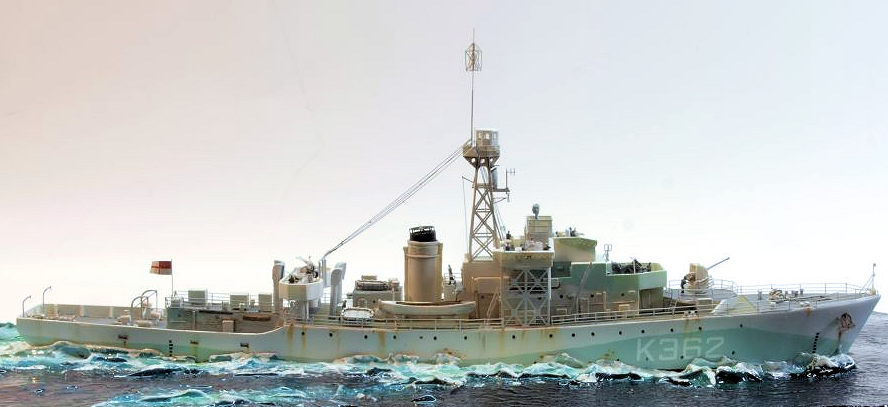
WEM 1/350 HMS Portchester Castle
| KIT #: | K 3580 |
| PRICE: | $ no longer available |
| DECALS: | None |
| REVIEWER: | Frank Spahr |
| NOTES: | Resin, White Metal, PE fret, wire, instructions |

| HISTORY |
The Castle Class was
designed in 1943 as Atlantic escorts and a successor to the Flower Class.
Both classes, and the more capable River Class, were designed by Smith´s
Dock Company in Middlesbrough. On the one hand, the new ships had an
improved hull form that eased the excessive rolling problems of the Flowers,
improved seakeeping and habitability. Moreover, the vessel had been
developed around the revolutionary new „Squid“ anti-submarine mortar. A new
ASDIC system registered the submarine´s position, depth and heading, and fed
this information in real time to the Squid. Upon reaching the best position,
the system would fore the weapon autom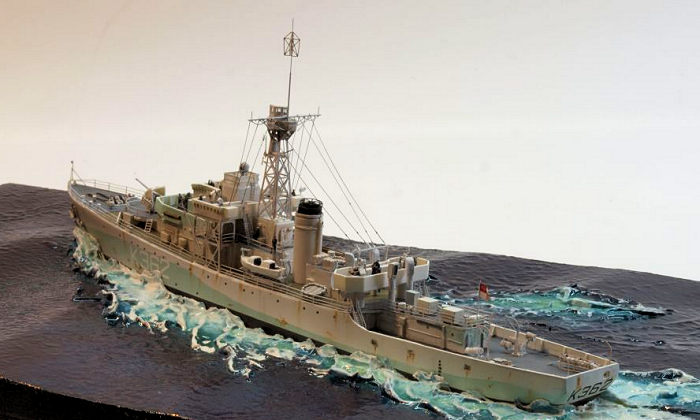 atically. The mortar launched three
projectiles so they would land in a triangle about 300 yards ahead of the
vessel, sinking rapidly to the predetermined depth, where their charge of
200 lbs. of Minol would detonate. The system worked up to a depth of 900 ft.
atically. The mortar launched three
projectiles so they would land in a triangle about 300 yards ahead of the
vessel, sinking rapidly to the predetermined depth, where their charge of
200 lbs. of Minol would detonate. The system worked up to a depth of 900 ft.
The success rate of a classic depth charge attack was estimated at about 6%. The newer „Hedgehog“ launcher, which fired 24 small projectiles with contact fuses, had raised the kill probability to 20%. Squid reached 50%, and thus increased the danger to the U-boats drastically. The system proved its worth in combat, and was soon introduced in the new classes of escorts. An improved version named „Limbo“ was in use into the 1980s.
The Castle Class corvettes were the low-end version of the new escorts. Having only one screw and the Flower class machinery,they were still rather slow at a mximum speed of 17 knots. Being small ships, they still could be built by smaller, less sophisticated shipyards. As far as possible, pre-fabricated parts were used. They were intended to bolster the number of escorts and support the more capable vessels of the River Class.
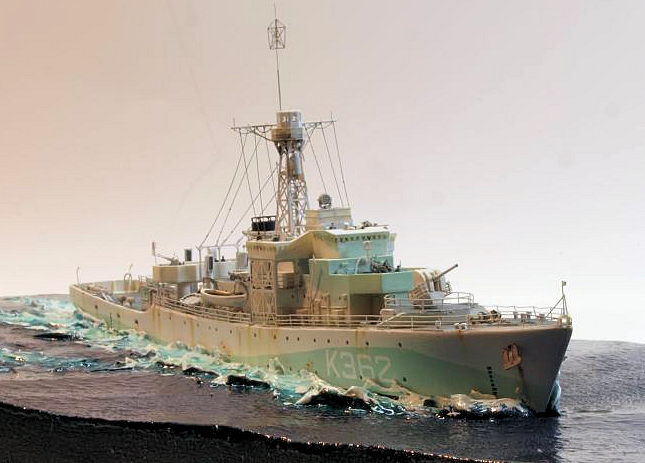 A total of 95 vessels
were ordered, out of which 44 were completed during the war. 10 out of them
were allocated to the RCN, one to the Royal Norwegian Navy. 55 vessels were
cancelled. Three Castles were lost during the war, a total of seven
submarines were sunk by Castle Class vessels. Most of the vessels were
scrapped in the 1950s, but a few soldiered on as weather observation
vessels.
A total of 95 vessels
were ordered, out of which 44 were completed during the war. 10 out of them
were allocated to the RCN, one to the Royal Norwegian Navy. 55 vessels were
cancelled. Three Castles were lost during the war, a total of seven
submarines were sunk by Castle Class vessels. Most of the vessels were
scrapped in the 1950s, but a few soldiered on as weather observation
vessels.
HMS Portchester Castle´s keel was laid on 17 March 1943, and she was completed on 8 November, 1943. She completed her workup at the end of 1943 and started escort service in February, 1944. She sank one U-boat and participated in the sinking of one other. After a refit between January and May 1945, she served first off the coast of West Africa, and later from Gibraltar, before laid up in reserve in 1946. In 1951 she was recommissioned as a training vessel operating out of Portland. During this time, she played the fictitious HMS Saltash Castle, in the second half of the classic movie „The Cruel Sea“. She sported her current pennant number of F (for frigate) 362. In the novel, HMS Saltash would have been a River class vessel, but obviously the production company could not lay their hands on one.
In June of 1956, HMS Portchester Castle was finally decommissioned, and scrapped at Troon in 1958.
| THE KIT |
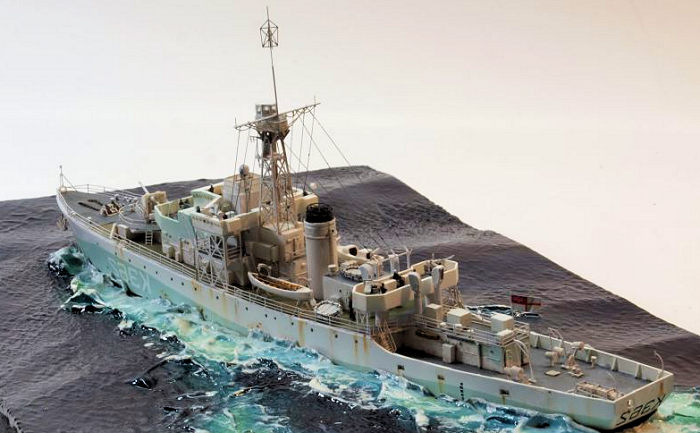 kit are now held by Peter Hall´s Atlantic Models, who has
reworked some of the parts. The kit is currently not on offer, but
pre-orders will be welcomed, as Peter told me.
kit are now held by Peter Hall´s Atlantic Models, who has
reworked some of the parts. The kit is currently not on offer, but
pre-orders will be welcomed, as Peter told me.
It is a typical WEM kit, with decent and well-fitting resin parts needing only little cleanup. There is an optional lower hull for full hull presentations. The white metal parts are rougher and cruder, but mostly workable. The important Squid launcher is the exception, and I soon felt the need for a replacement. The PE fret is comprehensive and well designed. An early and late fit may be realized. Sadly the fret is on the thicker side, and some parts are hard to bend, especially the inclined ladders. The fret comprises name plates for 24 vessels of the class. It should have contained a decal sheet with hull numbers, but mine missed it.
| CONSTRUCTION |
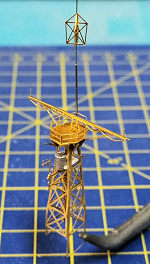 I have developed a
certain amount of routine now with WEM kits. This kit is rather small and
has only a limited parts count, so it was pleasant and fast to build. I
first cleaned up and glued the hull parts, as I needed a full hull for a
display in a lively sea. Then I tackled the various superstructure parts,
cleaned them up and checked their fit. I only needed filler at one point.
Now I was able to address the subassemblies. The most complex amongst them
was the lattice mast with its various sensors and platforms, which was
demanding to build, but doable. I prepared the PE lattice bridge wing
supports and checked for fit with the superstructure. I had to remove some
resin at the starboard side.
I have developed a
certain amount of routine now with WEM kits. This kit is rather small and
has only a limited parts count, so it was pleasant and fast to build. I
first cleaned up and glued the hull parts, as I needed a full hull for a
display in a lively sea. Then I tackled the various superstructure parts,
cleaned them up and checked their fit. I only needed filler at one point.
Now I was able to address the subassemblies. The most complex amongst them
was the lattice mast with its various sensors and platforms, which was
demanding to build, but doable. I prepared the PE lattice bridge wing
supports and checked for fit with the superstructure. I had to remove some
resin at the starboard side.
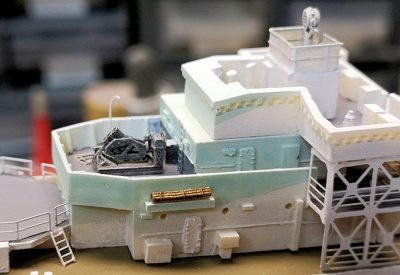 I was able to solve the
Squid issue via Shapeways. I found a designer offering Squids in larger scales,
and asked him whether he could scale his offering down to 1:350. He could, and
would, and actually did with less than 24 hours, and soon after I had the
printed part, together with a nice printed 27´ whaler and flotanets, ubiquitous
on RN vessels at the time.
I was able to solve the
Squid issue via Shapeways. I found a designer offering Squids in larger scales,
and asked him whether he could scale his offering down to 1:350. He could, and
would, and actually did with less than 24 hours, and soon after I had the
printed part, together with a nice printed 27´ whaler and flotanets, ubiquitous
on RN vessels at the time.
Another item I noticed as being below par was the anchor winch. I drew a blank at Shapeways, but luckily had the Starling Models kit of a River class frigate, which contained a very neat winch that seemed to be just what I needed. I asked Starling Model´s Mike McCabe if he could sell me a replacement winch, so I could use the kit part on the Castle, which he said he would. Only then did I realize that my River Class kit by some fluke contained two winch parts – problem solved!
| COLORS & MARKINGS |
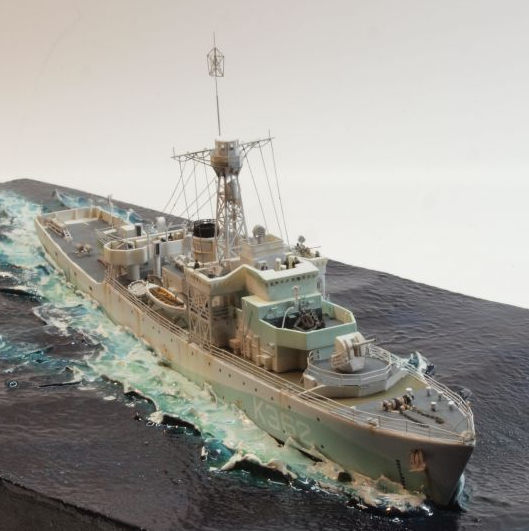 I pre-bent the kit
railings and mounted them for painting. The white metal cowl vents needed any
detail as to their opening, so I glued rectangles of PE railing to mark their
shape. I made the base early on in the project in my usual method.
I pre-bent the kit
railings and mounted them for painting. The white metal cowl vents needed any
detail as to their opening, so I glued rectangles of PE railing to mark their
shape. I made the base early on in the project in my usual method.
Having prepared all the subassemblies, I de-greased the hull as good as I could and primed all the parts using Stynylrez primer. For painting I used Stynylrez in white, grey and black, plus several shades of Vallejo ModelAir, plus Lifecolor´s Western Approaches White and Blue. I prefer working with Vallejo, as it brush paints better, and sadly the Blue looks rather Green after all, but never mind. Apart from the camo scheme which was masked and sprayed, most of the superstructure needed brushpainting. The hull numbers and draught marks are Hawk Graphic decals, applied after preparing the hull with Future to prevent silvering.
Now I was able to assemble the various components. I added some NorthStar figures and rigged the vessel with Albion Alloys .1 mm nickel silver wire. The White Ensign is a leftover from another WEM kit.
Sfetr some weathering using artist´s oils, I seled the model with a final flat coat using Winsor & Newton´s Galleria acrylics.
| CONCLUSIONS |
This is an attractive little vessel, a project of moderate complexity and time needed, and the model evokes the movie „The Cruel Sea“!
| REFERENCES |
https://en.wikipedia.org/wiki/Castle-class_corvette
Goodwin, Norman: Castle Class Corvettes. Liskeard 2007.
Brown, D. K. : Atlantic Escorts. Barnsley 2007
27 July 2020
Back to the Main Page Back to the Previews Index Page
Back to the Previews Index Page